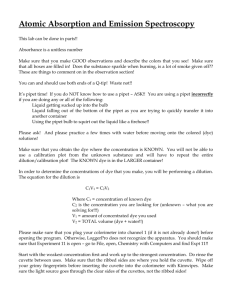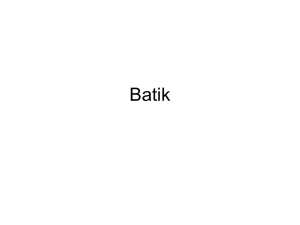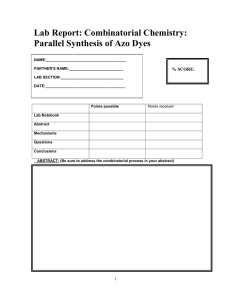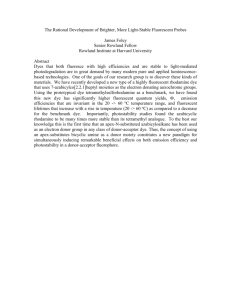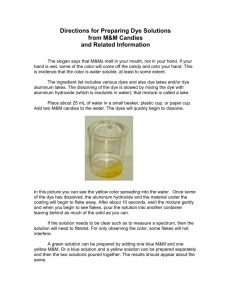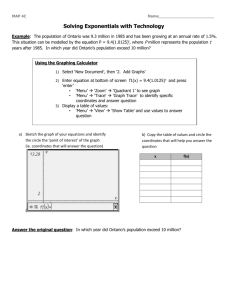Experiment 13I THE REACTION OF RED FOOD COLOR WITH BLEACH
advertisement
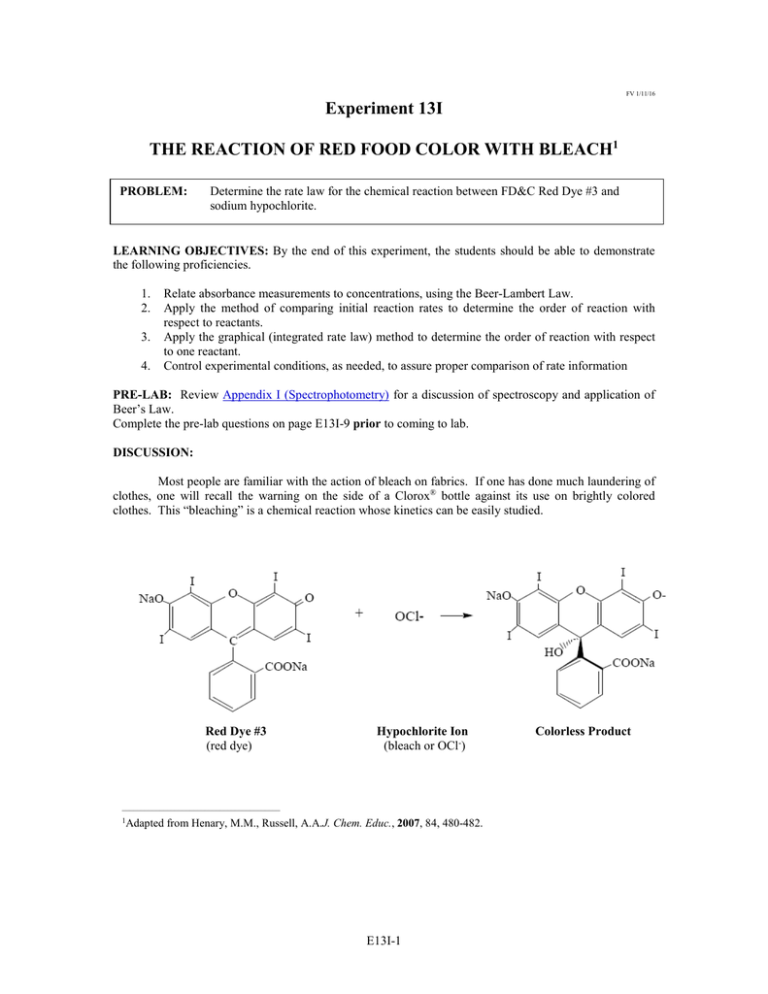
FV 1/11/16 Experiment 13I THE REACTION OF RED FOOD COLOR WITH BLEACH1 PROBLEM: Determine the rate law for the chemical reaction between FD&C Red Dye #3 and sodium hypochlorite. LEARNING OBJECTIVES: By the end of this experiment, the students should be able to demonstrate the following proficiencies. 1. 2. 3. 4. Relate absorbance measurements to concentrations, using the Beer-Lambert Law. Apply the method of comparing initial reaction rates to determine the order of reaction with respect to reactants. Apply the graphical (integrated rate law) method to determine the order of reaction with respect to one reactant. Control experimental conditions, as needed, to assure proper comparison of rate information PRE-LAB: Review Appendix I (Spectrophotometry) for a discussion of spectroscopy and application of Beer’s Law. Complete the pre-lab questions on page E13I-9 prior to coming to lab. DISCUSSION: Most people are familiar with the action of bleach on fabrics. If one has done much laundering of clothes, one will recall the warning on the side of a Clorox® bottle against its use on brightly colored clothes. This “bleaching” is a chemical reaction whose kinetics can be easily studied. Red Dye #3 (red dye) Hypochlorite Ion (bleach or OCl-) __________________________________________ 1Adapted from Henary, M.M., Russell, A.A.J. Chem. Educ., 2007, 84, 480-482. E13I-1 Colorless Product The rate of the bleaching reaction is dependent on the concentration of red dye and on the concentration of bleach. This is expressed in the rate law for the reaction: rate = k [red dye]a [OCl–]b (1) Experimental data will allow the values of the orders with respect to each reactant, a and b, to be determined. Determination of a: Pseudo Rate Law Method (graphical). One method for determining reaction orders outlined in general chemistry textbooks involves determining whether a reaction follows certain graphical profiles. However, this method can only be applied if the rate law for the reaction involves only one reactant. This may appear rather limiting, since most chemical reactions involve at least two reactants. As shown below, however, there is a way, in principle, to cause a reaction involving multiple reactants to appear to include the change in only one reactant. This method is known as the Pseudo Rate Law Method. By running the bleaching reaction with a large excess of bleach, OCl– , the Δ[OCl–] will be approximately equal to zero, therefore, k′ = k[OCl–]b and the rate law simplifies to: rate = k′[red dye]a and the rate of reaction leads directly to the order with respect to red dye, a. Determination of b: Method of Initial Rates. The Method of Initial Rates for determining orders of reaction is illustrated in Example 13.3 (pp. 517-519) of the Kotz textbook. This method involves a comparison of two different trials, the only difference between the trials being the concentration of one of the reactant species. The value of b in this experiment will be found by this method through holding the concentration of red dye constant and changing the concentration of OCl–. Since all of the reactions studied in this experiment involve a species (red dye) that will absorb visible light a Spectrophotometer (Spectronic 200) will be used to collect Percent Transmittance (%T), from which you can calculate the absorbance (A), which can then be related to concentration (c) data using the Beer Lambert Law: A = −log (%T/100) (2) A = εlc (3) where l = pathlength of the cuvette (1.00 cm in this experiment) and ε = molar absorptivity for red dye. E13I-2 MATERIALS: 100 mL volumetric flask, 50 mL beaker (2), 5 mL pipet (1), 2 mL pipet (3), 1 mL pipet (2), test tubes, Spec-200 (1), cuvette (1), rubber stopper for test tubes (1), plastic droppers. PROCEDURE: SAFETY: ALWAYS wear safety goggles and an apron, and handle the intensely colored dye carefully to avoid stains on clothing. Sodium hypochlorite, household bleach, is a bronchial irritant. Keep solutions in the hood, and avoid breathing the vapors. Immediately wipe-up any spills of the red dye or bleach. Part A. Prepare a diluted red dye solution from the initial stock solution & determine the percent transmittance 1. On the data sheet, record the concentration of the stock solution to four decimal places 2. Obtain about 10 mL of the red dye stock solution in a 50 mL beaker. 3. Rinse the inside walls of a 5.00 mL pipet with a small amount of the red dye stock solution, then transfer 5.00 mL of the red dye into the 100 mL volumetric flask. Carefully fill the flask up to the 100.0 mL mark with distilled water. Cap the flask and invert the solution several times to mix well. It is THIS SOLUTION that will be used in all reaction mixtures described in Part B. 4. Using distilled water as a blank, follow the provided directions to prepare the Spec-200 for use. 5. Transfer 2.00 mL of your dilute solution from Part A (3.) into a clean, dry cuvette. Insert the cuvette with the dye into the sample compartment. Following the provided directions, scan the spectrum of the red dye. Set the wavelength of the Spec-200 to the wavelength with the highest absorbance. 6. Set the instrument to Absorbance mode and record the Absorbance, A, at your selected wavelength on the data sheet. Note: From this you will be able to calculate the molar absorptivity, ε, of the red dye solution. Part B. Percent Transmittance measurements of reaction mixtures 1. Obtain about 15 mL of the hypochlorite solution in a 50 mL beaker. Record the weight percent of the bleach solution on the data sheet. 2. Use the solution from Part A(3.) to perform the first kinetic run. 3. Following the provided directions, put the Spectronic 200 into Percent Transmittance, %T, mode. 4. Transfer 4.00 mL of your dilute solution from Part A (3.) into a clean, dry test tube. The easiest way to transfer 4.00 mL to a small test tube is by using a plastic pipet to transfer 4.00±0.02 g of the dye solution into a tared test tube placed in a small beaker. USE THE TOP LOADING BALANCE. 5. READ THIS ENTIRE SECTION BEFORE BEGINNING. Transfer 2.00 mL of bleach solution into a clean, dry test tube. Use a clean, dry plastic pipet to withdraw all of the hypochlorite solution into the plastic pipet. To initiate the reaction, squirt the bleach solution into the test tube containing the dye. Stopper the test tube, invert once to mix. Transfer 2.0 mL of the mixture to a clean dry cuvette, wipe the outside of the cuvette with a lab tissue and insert into the Spec-200. Start recording time and percent transmittance readings. Record the percent transmittance every 30 seconds for 10 minutes or until the percent transmittance reaches 75.0%, whichever comes first. Record time vs percent transmittance on the data sheet. E13I-3 6. For reaction #2, the same procedure will be used. First, fill a test tube with appropriate amounts of dye solution and water. Next, transfer 1.00 mL of bleach solution into a second clean, dry test tube. Use a clean, dry plastic pipet to withdraw all of the hypochlorite solution into the plastic pipet. To initiate the reaction, squirt the bleach solution into the test tube containing the dye-water mixture. Stopper, mix and transfer 2.0 mL of the mixture to a cuvette. Record the percent transmittance every 60 seconds until it reaches 75.0% or 20 minutes whichever comes first. Remember to remove the cuvette between readings. Reaction # dye solution (mL) deionized water (mL) bleach solution (mL) 1 2 4.00 4.00 0.00 1.00 2.00 1.00 Clean up: 1. Be sure to remove the sample from the Spec-200! Discard all solutions in the sink. Wash and rinse glassware thoroughly to remove red dye and bleach residue. Shut down the Spec-200 as instructed. E13I-4 Name __________________________________ Section ____________ Name __________________________________ Date ______________ DATA SECTION Experiment 13I Part A. Concentration and Absorbance of red dye solutions & mass percent of bleach Note: Use proper significant figures and units. 1. Initial concentration of red dye stock solution (in g/L): ____________________ g/L 2. Initial concentration of red dye (MW = 879.9 g/mol) stock solution (in mol/L): ____________________ mol/L 3. Record the Absorbance of the solution prepared in Part A (6.): __________(no units) 4. Mass percent of sodium hypochlorite in the bleach: ______________ Part B. Absorbance data for each reaction mixture Time (sec) Absorbance Reaction #1 Time (sec) E13I-5 Absorbance Reaction #2 Name __________________________________ Section ____________ Name __________________________________ Date ______________ CALCULATIONS & DATA TREATMENT Experiment 13I Part A. Determining concentrations & molar absorptivity Note: Use proper significant figures and units. (A.1) Using M(conc)V(conc) = M(dilute)V(dilute) and the initial concentration of the stock solution recorded in Part A, calculate the concentration of the red dye solution you made in Part A (3). [red dye] Part A(1) ______________________ [red dye] Part A(3) __________________________ (A.2) Use Beer’s Law and the absorbance recorded in Part A (6) to calculate the molar absorptivity of the red dye solution. Molar absorptivity ________________ (A.3) Mass percent of sodium hypochlorite in the bleach: ______________ (A.4) Assuming that the density of bleach solution is 1.00 g/mL, calculate the molarity of the sodium hypochlorite in the stock bleach solution provided. (A.5) Using M(conc)V(conc) = M(dilute)V(dilute), calculate the molarity of the sodium hypochlorite in reaction mixtures #1 and #2: [bleach] Reaction #1 _______________ [bleach] Reaction #2 _______________ E13I-6 Part B: Data analysis For a refresher on using Excel to perform calculations and graph data, check out the tutorials on the Chemistry Department website. (B.1) Enter your time and percent transmittance data for Reaction #1 into an Excel spreadsheet. (B.2) Create new columns for Absorbance, [red dye], ln[red dye], and 1/[red dye]. Do not use your calculator - ENTER FUNCTIONS into the spreadsheet to perform each calculation! Recall that: (B.3) Abs = [red dye] ε × Prepare three plots using your data from Reaction #1: [red dye] vs. time, ln[red dye] vs. time, and 1/[red dye] vs. time. The plot that visually appears the most “linear” tells you the order of the reaction, with respect to [red dye]. Perform linear regressions on each plot. The plot with the R2 value closest to 1.0 is the most linear. Note: Record which plot has an R2 value closest to 1.0: _________________________ Record the order with respect to [red dye], a: ________________________ (B.4) Enter time and percent transmittance data for Reaction #2 in the same Excel worksheet. Refer to your record of which plot was most linear (B.3) and construct this same plot for Reaction #2. Perform a linear regression on the plot, making sure to include the equation of the trend-line and R2 value for the graph. Note: Use the slope of each trend-line to solve for the order in bleach Slope (= -k’EXP#1 if 1st order, = k’EXP#1 if 2nd order) of trend-line Rxn #1: _________________ Slope (= -k’EXP#2 if 1st order, = k’EXP#2 if 2nd order)of trend-line Rxn #2: _________________ (B.5) By comparing the slopes of the trend-lines for Reactions #1 and #2 and the initial bleach concentrations calculated in (A.5), determine b, the order of the reaction with respect to bleach (i.e. OCl-). Remember, the slopes of your graphs equal –k′ if the reaction is 1st order and equals k’ if the reaction is 2nd order, and k is numerically the same for both reactions. k 'EXP #1 k [OCl − ]bEXP #1 = k 'EXP # 2 k [OCl − ]bEXP # 2 (B.6) Write the experimental rate law based on the order of the red dye and the order of the OCl- that you obtained in your analysis (B.7) Calculate the rate constant, k, for this reaction (remember to include proper units) E13I-7 QUESTIONS Experiment 13I 1. For Reaction #1, determine the number of moles of red dye and of sodium hypochlorite in the test tube. Determine the final number of moles of red dye and of sodium hypochlorite. (HINT: Determine which reactant is limiting.) Initial moles of NaOCl ________________ 2. Final moles of NaOCl. _________________ In the pseudo rate law method used to determine the order in red dye, it is important that the concentration of the hypochlorite ion remain constant. Using your values from question 1, was this true? Explain. E13I-8 Name __________________________________ Section ____________ Date ______________ PRE-LAB EXERCISES Experiment 13I BRING YOUR LAPTOP TO LAB 1. Calculate how many grams of sodium hypochlorite (NaOCl) solution were dissolved in 1.00 L of distilled water to give a 0.81 M stock solution. 2. Calculate the molarity of a solution of red dye #3 (MW 879.9 g/mol) if a 3.0104 g sample is diluted with distilled water to 10.00 L. 3. Calculate the dye concentration of a solution made by adding 5.00 mL of the solution from question #2 above into a 100.00 mL volumetric flask and diluting with distilled water to the 100.00 mL mark. 4. Calculate the [dye] and [OCl-] (both in moles/L) when 2.00 mL of the bleach solution from question #1 is added to 4.00 mL of the dye solution in question #3. E13I-9
